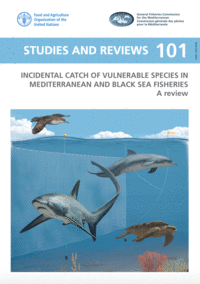
Incidental catch of vulnerable species in Mediterranean and Black Sea fisheries:
A review
Abstract
This publication offers an overview of historical and current trends in the bycatch of five important groups of vulnerable species in the Mediterranean and the Black Sea: seabirds, sea turtles, elasmobranchs, marine mammals and macrobenthic invertebrates. Interactions between these groups and fisheries are known to occur in the context of nearly all commonly used types of fishing gear and can result in injury or death to the animals. Each chapter in this review focuses on one of the five groups of vulnerable species, describing and presenting data from surveys and studies conducted over recent decades. The chapters are further subdivided according to fishing gear and GFCM subregion (western, central and eastern Mediterranean, the Adriatic Sea and the Black Sea).
The incidental catch records included in this review are derived from a variety of approaches. Surveys completed by onboard observers, while demanding more time and resources, represent the most comprehensive and accurate of these methods. Less reliable data come from non-systematic, opportunistic data collection, such as questionnaire surveys answered by fishers. Though many geographic areas and vessel groups remain underrepresented in the available data, coverage has generally increased in recent years and insight continues to emerge on the key dynamics governing the bycatch of vulnerable species in the Mediterranean and Black Sea.
Seabird bycatch has mainly been recorded from the western Mediterranean and in longline fisheries. Bottom trawlers, on the other hand, have the greatest impact on sea turtles, especially in the northern Adriatic Sea, Tunisia, Egypt and Turkey. The vessel groups most implicated in elasmobranch bycatch vary by subregion, with longliners accounting for nearly 80 percent of incidental captures in the central Mediterranean, for example, while pelagic trawlers are responsible for an even greater majority of incidental captures in the neighbouring Adriatic Sea. Historically, marine mammals were often caught in large-mesh driftnets, but the incidental capture of these species has declined since bans on driftnets were put in place in the late 1990s. Unsurprisingly, macrobenthic invertebrates, including soft and hard corals, sponges, echinoderms and molluscs, are most affected by bottom trawls, as they are dragged across the seafloor these species inhabit.
Vulnerable species are not the only ones to come out the worse for wear from their interactions with fishing activities. Fishers also risk economic losses resulting from damage done to their nets by entrapped individuals or from the depredatory behaviour of species that feed on bait meant to lure target species. Raising awareness amongst fishers and relevant stakeholders of the threats currently facing vulnerable populations across the Mediterranean and the Black Sea, as well as their importance to local ecosystems, will help to improve relations between fisheries and these species and to ease transitions toward safer practices. New technologies that can mitigate the bycatch of vulnerable species must continue to be tested and implemented in fisheries and standardized procedures for data collection should be established to better understand the many factors influencing bycatch in the region.
Carpentieri, P., Nastasi, A., Sessa, M. & Srour, A., eds. 2021. Incidental catch of vulnerable species in Mediterranean and Black Sea fisheries: a review. GFCM Studies and Reviews No. 101. Rome, FAO
PDF <
